In Boulder, Colorado, a New Climate Reality Arrives: Year-Round Fire Season
Local communities like Chautauqua are banding together in response
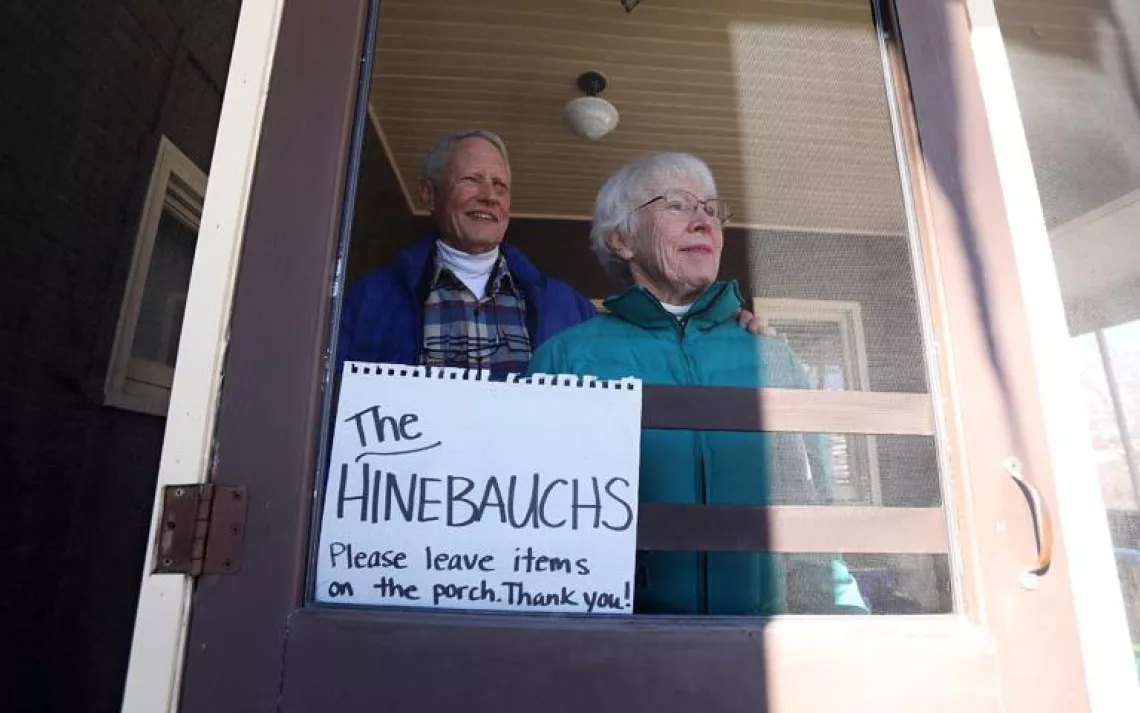
Jon and Elizabeth Hinebauch
In mid-December 2021, Brigid Moriarty was driving her seven-year-old son, Joaquin, to school near their home in Louisville, Colorado. During the routine drive along Highway 36, they listened to NPR’s Brains On! podcast, as they often did. The episode was about what causes wildfires.
“We’re listening to the show and Joaquin says to me, ‘Mom, would a fire come to Louisville?’” Moriarty told Sierra. “And I said, ‘No, it’s so unlikely; there’s a lot of grass around us, but if the grass caught fire the firefighters would be able to put it out before it came to where we are.’ We’re pretty far into a residential neighborhood.”
Two weeks later, the Marshall Fire ruined their house.
The Moriarty home is one of over 1,000 structures that were either completely destroyed or rendered uninhabitable by the monster fire. While its exact cause is still being investigated, the impact was swift and severe: On December 31, a huge plume of smoke suddenly billowed over the valley. Within a matter of hours, flames driven by muscular 100-mile-per-hour winds raced across densely populated urban neighborhoods throughout southeast Boulder, devastating every structure in their path. The conditions for an inferno were prime: A drought that year had baked the surrounding grasslands for months. Once the thing got going, there was little anyone could do but watch or run until snow moved in a few days later to pacify it. Thousands of families were forced to evacuate; for many, it would be the last time they would see their home or anything inside it.
In the case of the Moriartys, actual flames never touched their house. But for hours, the winds plowed wildfire smoke into the structure, and along with it, the potentially lethal toxins that fill the air when PVC pipe, drywall, insulation, and other building materials are vaporized by flames. Everything in their home was blanketed in potentially toxic soot and ash. An independent public adjuster with whom they consulted pointed out that in California, they would probably be required to take the house down to the studs and rebuild it from scratch because of their proximity to the fire.
After taking refuge in a hotel for a few weeks, the Moriartys quickly realized they would need a longer-term solution for housing. That’s when Brigid thought of Chautauqua.
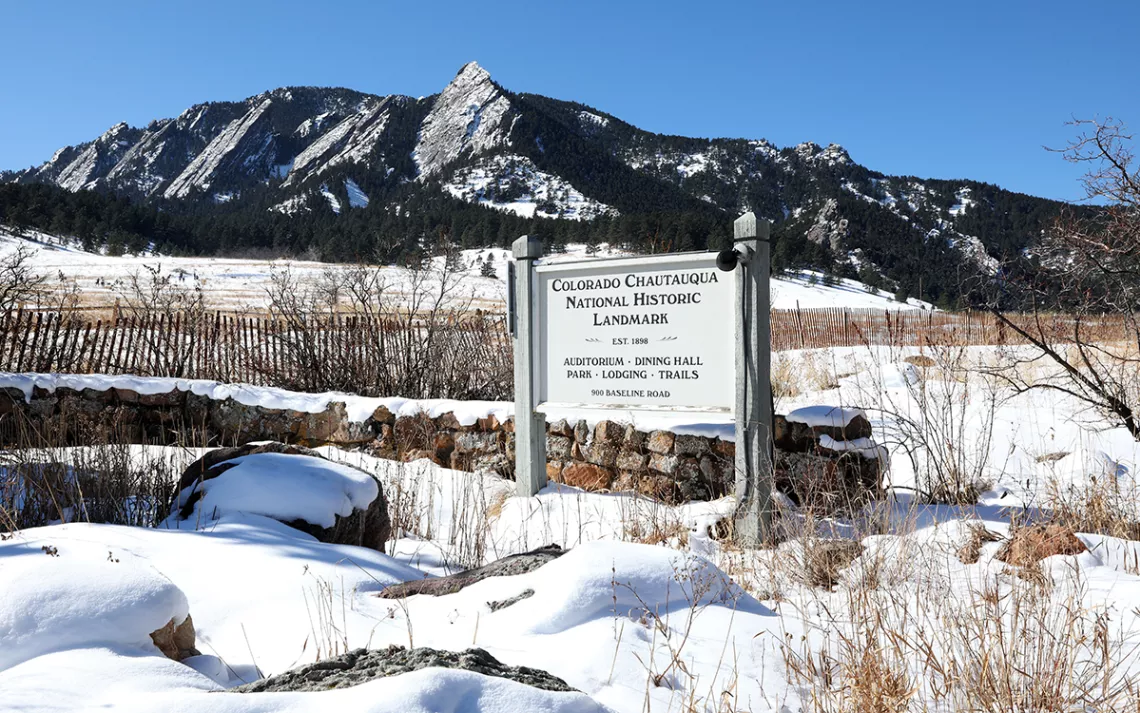
“A deep breath in a natural refuge”
Situated on the edge of Boulder and the Flatirons mountains, just a few miles from Pearl Street downtown and the University of Colorado Boulder, Chautauqua is one of 26 national historical landmarks in Colorado and one of only two that have lodging. The historic village was founded on the fourth of July in 1898 as part of the Chautauqua movement of communities that spread across the United States at the turn of the century. Most of the village's 99 cottages were built between 1901 and 1945. The community also offers a large dining hall; an auditorium that seats 1,300 people for classical concerts, pop concerts, and ballet; public art exhibits; a general store; a large green space open to the public for picnic and special events; and over 40 miles of hiking trails.
In the aftermath of the Marshall Fire, Chautauqua converted itself into a refuge for families in need. The dining hall provided nearly 1,000 free meals to those impacted by the crisis, even after some of those same dining hall employees serving those meals lost their own homes in the fire. For locals who lost everything, Chautauqua offered cottages still vacant on the property at drastically reduced rates, which were then picked up by insurance companies.
The Moriartys were one of those families. Brigid, who used to come to Chautauqua for winter staycations or to hike and enjoy the trails, reached out to see if they had longer-term rentals available. Staff not only offered the Moriartys a cottage at a fraction of the rate it normally costs, but also worked behind the scenes to formalize the arrangements with their insurance company and helped secure the Moriartys access to essential resources.
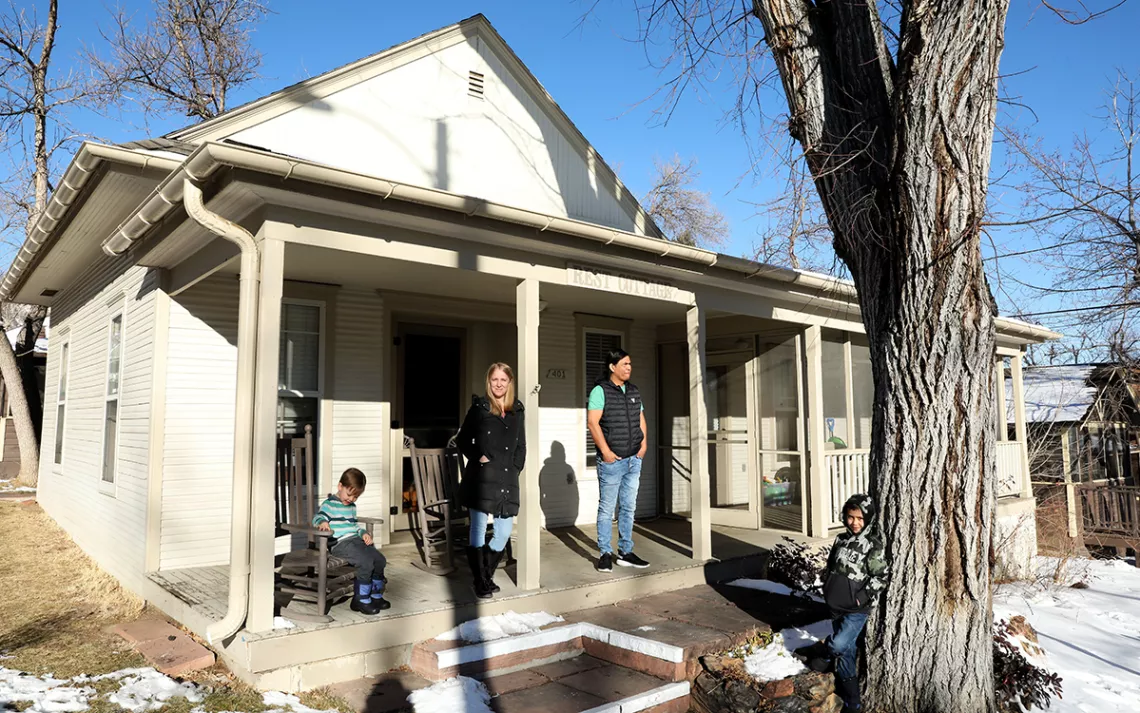
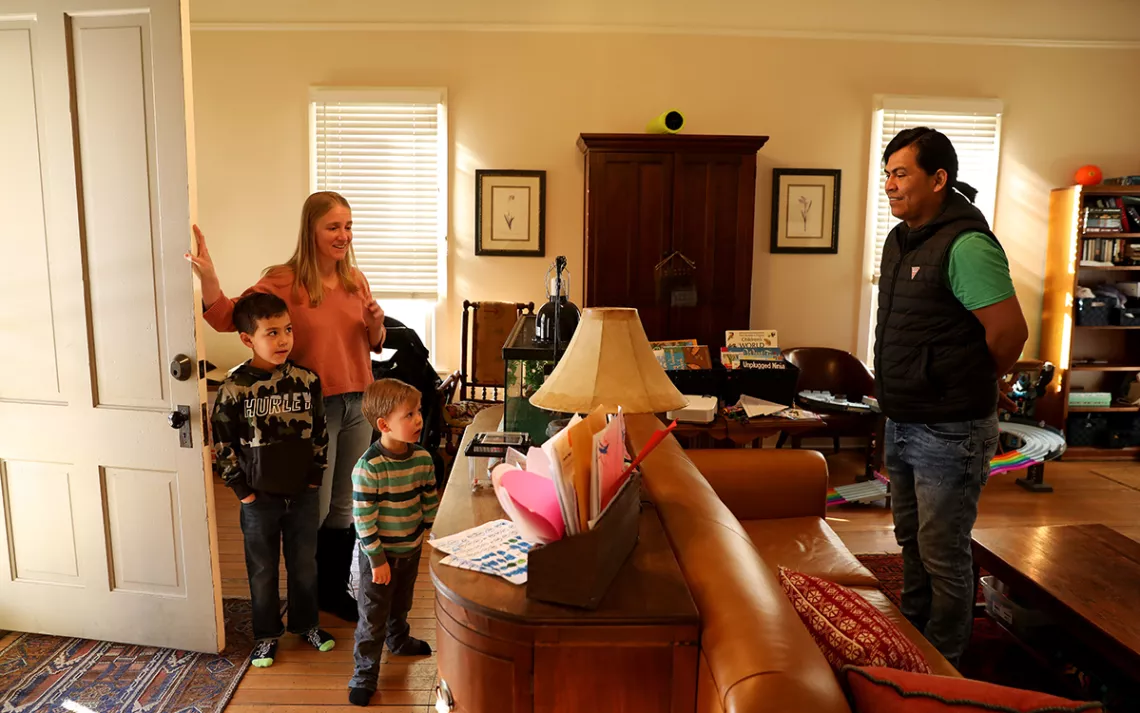
Brigid Moriarty with her husband, Vinicio, and their two kids at Chautauqua
“They have no TVs here. They have this great park. There are all these trails,” Moriarty says. “The kids go outside all the time. It feels like a healthier environment for us to be in after everything we’ve been through. We were able to take a deep breath in a natural refuge.”
“We see ourselves as a community resource,” Liza Purvis, the director of marketing and communications at Chautauqua, says. “People can come and sit in our gardens, walk around the grounds, and be close to nature. We welcome the community to take respite on our campus whenever these kinds of tragedies arise. That’s one of our core values: love of nature.”
Chautauqua organized meet-and-greets with the families it was supporting in the fire’s aftermath—26 families in all—so they could connect, talk, and share stories and also learn how to get access to crucial resources. One of those families was the Hinebauchs.
“All of a sudden, everything is gone”
Jon and Elizabeth Hinebauch met in high school in New Jersey and have been going steady ever since. This year, they celebrated their 60th anniversary. In 1971, on a lark, they moved to Boulder after Jon maneuvered himself into a new marketing position for a start-up outdoor gear company. While Elizabeth was taking care of their two kids, he flew out to Boulder to meet with a real estate agent. “I told the agent that I was a city slicker from New York, and I wanted to see the mountains,” Jon says. “He took me up on the Davidson mesa where there were just a few homes, and we stood there, looking out on the front range. I said, ‘This would be a great place for a house.’”
They built that house right there on the top of the mesa, overlooking the city of Boulder, with views that on a clear day could reach all the way to Pikes Peak—over 100 miles to the south. Jon and Elizabeth raised their two kids, Melissa and Garet, and lived there for 51 years.
It took the Marshall Fire just hours to raze it to the ground.
A few days before the fire, the Hinebauchs had returned from New Hampshire, where they had been visiting Melissa’s family for the Christmas holiday. Their suitcases, still full of red and green turtlenecks and pull-overs, hadn’t been unpacked yet. On December 31, they were having lunch when Elizabeth first noticed the billowing cloud of smoke. The sight wasn’t unusual at first: Over the years, from that vantage high up on the mesa, they had seen smoke from other fires that came and went. None of those fires ever directly threatened their home. “We didn’t worry about the cloud in the beginning,” Elizabeth says. “It looked like a sandstorm. But then we realized it was smoke.”
Jon and Elizabeth began collecting passports and other important papers like their Social Security and Medicare cards. Then they got a reverse 911 warning to evacuate. They grabbed their suitcases with the holiday clothes and their papers and left. “If we had thought that our house wasn’t going to be here when we got back we would have grabbed certain antiques, certain artwork off the walls,” Jon says. “We pretty much took nothing except our suitcases from the holiday.”
They went to a friend’s house in Louisville. But soon after they got there, that neighborhood was ordered to evacuate too. The Hinebauchs ended up at a hotel 15 miles away in Longmont. The next day, a neighbor hiked up to their street to check on what happened. He sent Jon and Elizabeth a picture of what was left of their house: a chimney poking out of ash and rubble.
“You go into shock right off, and a state of disbelief,” Elizabeth says. “It’s hard to really comprehend that your life and your wonderful home full of memories and the comforts that you established in the home are all gone. That realization comes on you both quickly and slowly. All of a sudden, everything is gone.”
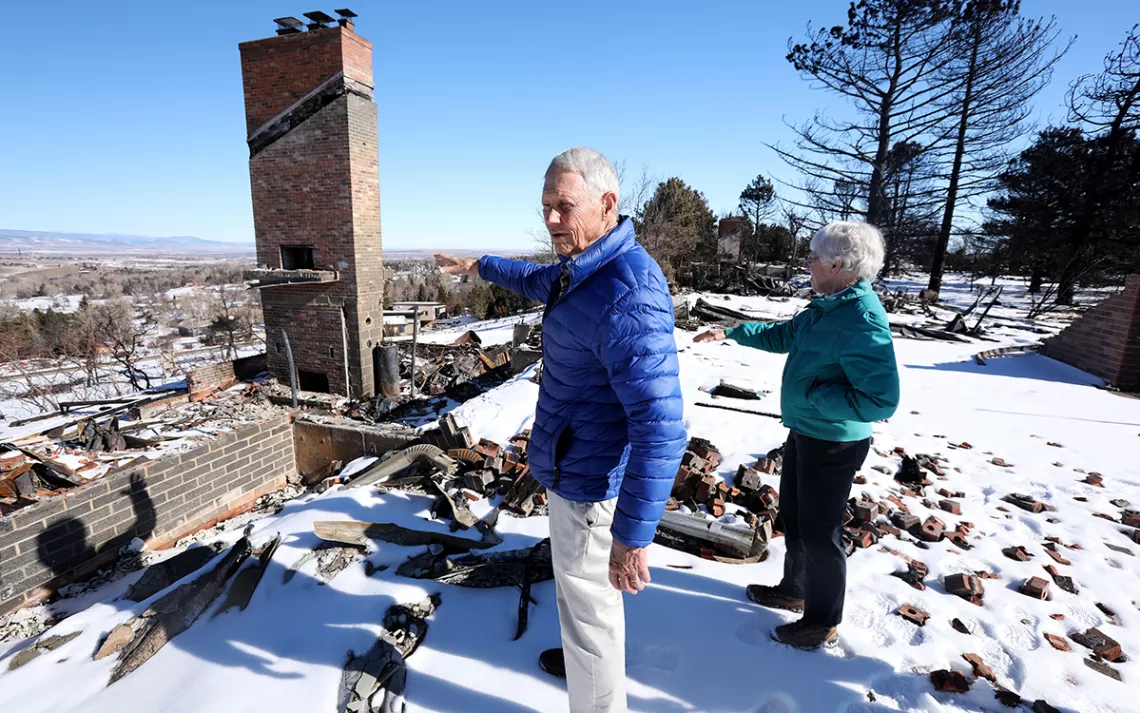
Jon and Elizabeth Hinebauch stand near what is left of their home after the Marshall Fire.
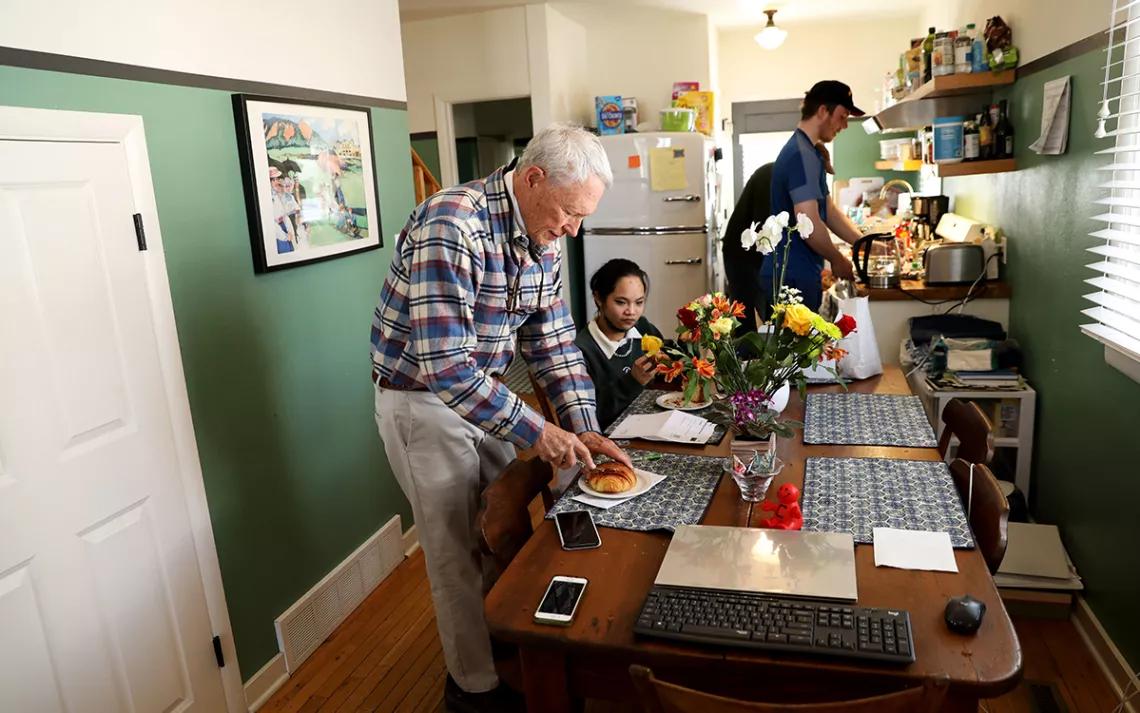
Jon and Elizabeth Hinebauch with their family at Chautauqua
Melissa called Chautauqua and got the last available cottage left—a three-bedroom, two-bath structure was big enough to house their entire family. “We ate in the dining hall and they offered free meals for evacuees,” Elizabeth says. “It made us feel like we had landed in a place where people cared about us and were there to offer sympathy and support.”
The difficult question they now face: whether to rebuild.
“We are 81 years old,” Elizabeth says. “We know that it would take at least three or four years to rebuild.”
“We will get back on our feet”
Four months after the Marshall Fire, the Moriarty family is still at Chatauqua. Their independent public adjuster advised hiring an industrial hygeniest to test for toxic soot in their home and to determine how deeply the structure was pentetrated by it. They are still trying to sort that out with their insurance company; until that's resolved, they can't go back to their house.
The Hinebauchs have since taken a year lease on an apartment to give them more time to consider their options. Even if they wanted to reconstruct their home, with thousands of families looking to do the same, contractors are scarce—it could take months or even years to rebuild.
While the Moriartys and the Hinebauchs, their Chautauqua community, and the thousands of others impacted by the Marshall Fire are trying to move forward, the wildfire season—and the climate conditions amplifying it to extremes—has not let up. Early this month, the NCAR Fire forced the entire Chautauqua community to evacuate, including the remaining families living there whose homes were destroyed in December. While the fire was quickly brought under control, nerves are frayed, and everyone is on edge. Dry conditions have set the table for another monster fire, should the right ignition find its way to the right source of fuel. Last week, Interior Secretary Deb Haaland visited Boulder to raise awareness about wildfire danger and highlight new federal funding in response for states nationwide, of which $33 million will go to Colorado.
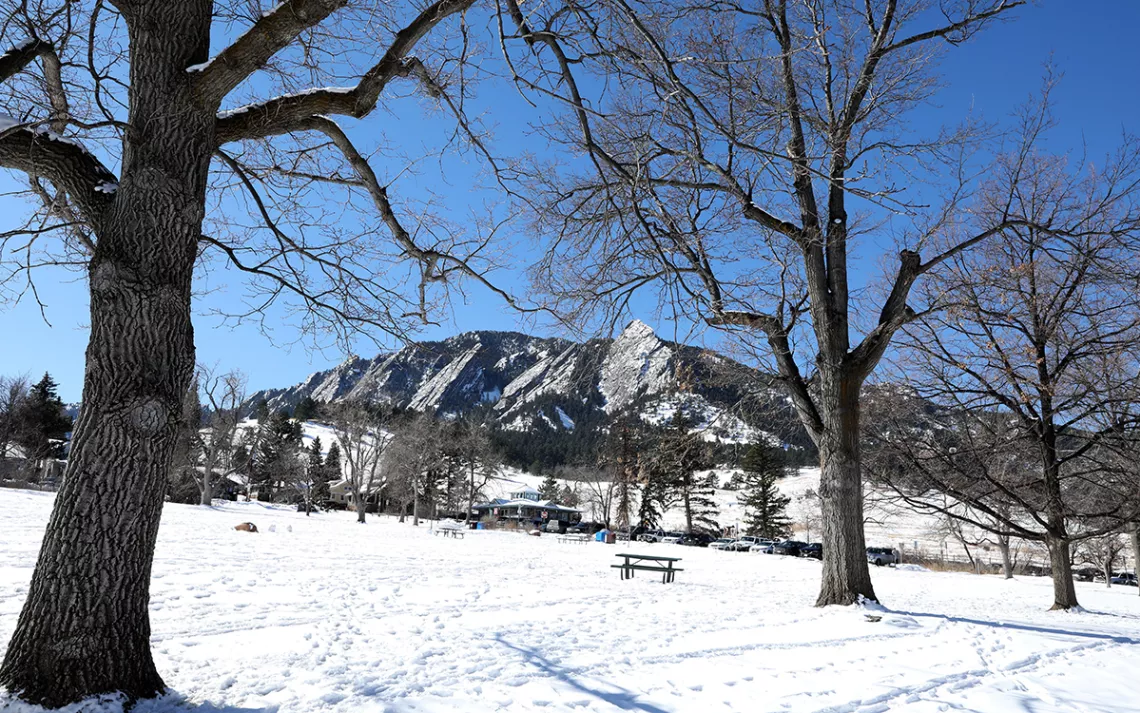
At Chautauqua, staff are already in the process of following through on a long-standing fire mitigation prevention and awareness program for their residents. “In light of what’s happened in the last several years, especially with the Marshall fire, we undertook a sustainability and resilience strategy in collaboration with the City of Boulder to insure our resiliency for the next 100 years,” Jeff Medanich, the director of preservation and sustainability at Chautauqua, says. “We did a vulnerability assessment, and to no surprise wildfires were our biggest threat.” For the past 10 years, Medanich has been working with firefighters and the City of Boulder to develop a business continuity plan that includes a detailed process for evacuating the entire village in response to a wildfire threat. Chautauqua successfully executed that plan when the NCAR Fire got too close.
Whatever happens, this community, with its “love of nature,” is determined to band together come what may.
“Climate change is here,” Jon Hinebauch says. “It’s affecting people that it hadn’t affected in their entire lives. People like us. But with this fire, I have just been amazed by how those who were not directly affected reached out to support those who were. Chautauqua was there for us. Our congregation in Boulder set up teams of people to help us get through the following weeks and months. They went to their suppliers and got thousands of dollars of first quality equipment and gear including down jackets and rainwear and gave it away on a daily basis. There are organizations in this town who are still giving away clothing and incidentals. Boulder knows how to handle something like this. We will get back on our feet.”
 The Magazine of The Sierra Club
The Magazine of The Sierra Club



